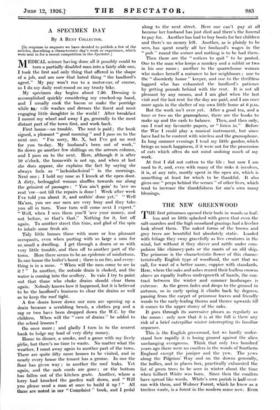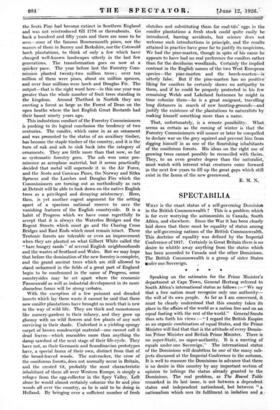THE NEW GREENWOOD
THE first primroses opened their buds in woods so leaf- - less and so little splashed with green that even the salt-marshes and the-high moorland grazings had a livelier look about them. The naked forms of the brown and grey trees are beautiful but absolutely static. Loaded with foliage they sway gracefully as live creatures in the wind, but without it they shiver and rattle under com- pulsion like chimney-pots or the masts of an old ship. The primrose is the characteristic flower of this charac- teristically English type of woodland, the sort that we call, for want of a better name, coppice with standards. Here, where the oaks and ashes reared their leafless crowns above an equally leafless undergrowth of hazels, the con- trast between the winter and summer landscapes is extreme. As the green fades and drops to the ground in autumn, so in early spring it climbs back by degrees, passing from the carpet of primrose leaves and friendly- weeds to the early-leafing thorns and thence upwards till it comes to the upper storey of the oaks.
It goes through its successive phases as regularly as the moon : only now that it is at the full is there any risk of a. brief caterpillar winter interrupting its familiar sequence.
This is the English greenwood, but we hardly under- stand how rapidly it is losing ground against the alien unchanging evergreens. Think that only two hundred' years ago there were no conifers in the woods of Southern England except the juniper and the yew.. The yews along the Pilgrims' Way and on the downs generally, the hollies, and in places. box, practically exhausted the list of green trees to be seen in winter about the time when Gilbert White was born. Since then the conifers have spread like weeds. White's own parish is half-over. run with them, and Wolmer Forest, which he knew as a treeless waste, is a forest in the modern sense now. Even the Scots Pine had become extinct in Southern England and was not -reintroduced till 1776 or thereabouts. Co back a hundred and fifty years and there are none to be seen—none of the famous Bournemouth pines, nor the• masses of them in Surrey and Berkshire, nor the Cotswold larch plantations, to think of only a few which have changed well-known landscapes utterly in the last few generations. The transformation goes on now at a quicker pace. The year before last the Forestry Com- mission planted twenty-two million trees; over ten • million of them were pines, about six million spruces, and over four millions were larch and Douglas Fir. The output—that is the right word here—in this one year was greater than the whole number of fruit trees standing in the kingdom. Around Thetford in Norfolk they are erecting a forest as large as the Forest of Dean on the open heaths where the last English Great Bustards had their haunt ninety years ago. This industrious conduct of the Forestry Commissioners is pushing. to its logical conclusion the tendency of two centuries. The conifer, which came in as an ornament and was promoted to the status of an auxiliary timber, has become the staple timber of the country, and it is the turn of oak and ash to sink back into the category of ornaments. They are little more than that now, so far as systematic forestry goes. The ash won some pro- minence as aeroplane material, but it seems practically decided that metal will supersede it in the Air Force, and the Scots and Corsican Pines, the Norway and Sitka Spruces and the Larches and Douglas Firs which the Commissioners are turning out as methodically as cars at Detroit will be able to look down on the native English trees as a privileged and decaying aristocracy. Here, then, is yet another cogent argument for the setting apart of a spacious national reserve to save the vanishing features of the English countryside. It is a habit of Progress which we have come regretfully to accept that it is always the Waterloo Bridges and the Regent Streets which must go and the Charing Cross Bridges and East Ends which must remain intact. These Teutonic forests are tolerable or even an improvement. when they are planted on what Gilbert White called the "bare hungry sands" of several English neighbourhoods and the wastes of Scotland and Wales. But we may hope that before the domination of the new forestry is complete, and the grand ancient trees which are still allowed to stand unharmed in the fields of a great part of England begin to be condemned in the name of Progress, some countrysides may be set apart where the economic Tannenwald as well as industrial development in its more shameless forms will be streng verboten. With the exception of a few puissant and dreaded insects which lay them waste it cannot be said that these new conifer plantations have brought us much that is new in the way of wild life. They are thick and monotonous like nursery-gardens in their infancy, and they grow up gloomy with no wild flowers and few plants of any sort surviving in their shade. Underfoot is a yielding spongy carpet of brown nondescript material—one cannot call it dead leaves—which resembles more than anything the damp sawdust of the next stage of their life-cycle. They have not, as their Germanic and Scandinavian prototypes have, a special fauna of their own, distinct from that of the broad-leaved woods. The nutcracker, the crow of the coniferous forests, does not normally occur in Britain, and the crested tit, probably the most • characteristic inhabitant of them all over Western Europe, is simply .a refugee from the egg-collector in the Spey Valley. Left alone he would almost certainly colonize the fir and pine woods all over the country, as he is said to be doing -in Holland. By bringing over a sufficient number of fresh clutches and substituting them for coal-tits' eggs in the conifer plantations i fresh stock could quite easily be introduced, barring accidents, but science does not welcome such introductions in principle, and the results attained in practice have gone far to justify its suspicions. We had the pine-marten, though in spite of his name he appears to have had no real preference for conifers rather than for the deciduous woodlands. Certainly the implied contrast in the English names of the two West European species—the pine-marten and the beech-marten—is• utterly false. But if the pine-marten has no positive liking for conifers he certainly shows no antipathy to them, and if he could be properly protected in his few remaining Welsh and Lakeland fastnesses he might in time colonize them—he is a great emigrant, travelling long distances in search of new hunting-grounds—and justify the existence of the plantations to naturalists by making himself something more than a name.
That, unfortunately, is a remote possibility. What , seems as certain as Abe. coming of winter is that the Forestry Commissioners will sooner or later be compelled to declare war on the grey squirrel and prevent him from digging himself in as one of the flourishing inhabitants of the coniferous forests. His ideas on the right use of growing trees cannot possibly be reconciled with theirs.. They, to an even greater degree than the naturalist, must watch with interest what creatures come forward in the next few years to fill up the great gaps which still _ exist in the fauna' of the new greenwood. E. M. N.























































 Previous page
Previous page